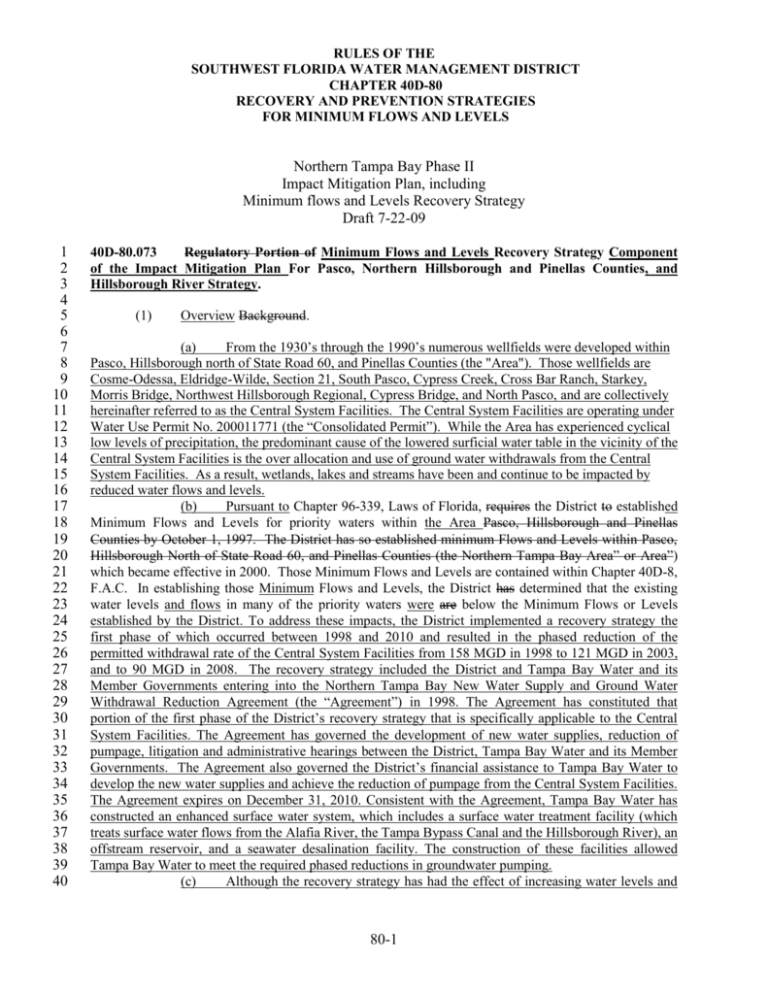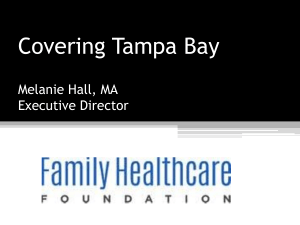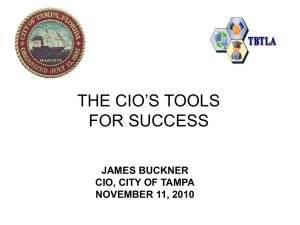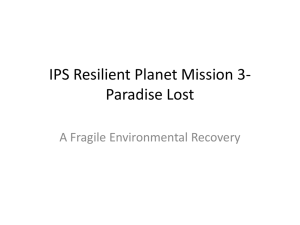RULES OF THE SOUTHWEST FLORIDA WATER MANAGEMENT
advertisement

RULES OF THE SOUTHWEST FLORIDA WATER MANAGEMENT DISTRICT CHAPTER 40D-80 RECOVERY AND PREVENTION STRATEGIES FOR MINIMUM FLOWS AND LEVELS Northern Tampa Bay Phase II Impact Mitigation Plan, including Minimum flows and Levels Recovery Strategy Draft 7-22-09 1 2 3 4 5 6 7 8 9 10 11 12 13 14 15 16 17 18 19 20 21 22 23 24 25 26 27 28 29 30 31 32 33 34 35 36 37 38 39 40 40D-80.073 Regulatory Portion of Minimum Flows and Levels Recovery Strategy Component of the Impact Mitigation Plan For Pasco, Northern Hillsborough and Pinellas Counties, and Hillsborough River Strategy. (1) Overview Background. (a) From the 1930’s through the 1990’s numerous wellfields were developed within Pasco, Hillsborough north of State Road 60, and Pinellas Counties (the "Area"). Those wellfields are Cosme-Odessa, Eldridge-Wilde, Section 21, South Pasco, Cypress Creek, Cross Bar Ranch, Starkey, Morris Bridge, Northwest Hillsborough Regional, Cypress Bridge, and North Pasco, and are collectively hereinafter referred to as the Central System Facilities. The Central System Facilities are operating under Water Use Permit No. 200011771 (the “Consolidated Permit”). While the Area has experienced cyclical low levels of precipitation, the predominant cause of the lowered surficial water table in the vicinity of the Central System Facilities is the over allocation and use of ground water withdrawals from the Central System Facilities. As a result, wetlands, lakes and streams have been and continue to be impacted by reduced water flows and levels. (b) Pursuant to Chapter 96-339, Laws of Florida, requires the District to established Minimum Flows and Levels for priority waters within the Area Pasco, Hillsborough and Pinellas Counties by October 1, 1997. The District has so established minimum Flows and Levels within Pasco, Hillsborough North of State Road 60, and Pinellas Counties (the Northern Tampa Bay Area” or Area”) which became effective in 2000. Those Minimum Flows and Levels are contained within Chapter 40D-8, F.A.C. In establishing those Minimum Flows and Levels, the District has determined that the existing water levels and flows in many of the priority waters were are below the Minimum Flows or Levels established by the District. To address these impacts, the District implemented a recovery strategy the first phase of which occurred between 1998 and 2010 and resulted in the phased reduction of the permitted withdrawal rate of the Central System Facilities from 158 MGD in 1998 to 121 MGD in 2003, and to 90 MGD in 2008. The recovery strategy included the District and Tampa Bay Water and its Member Governments entering into the Northern Tampa Bay New Water Supply and Ground Water Withdrawal Reduction Agreement (the “Agreement”) in 1998. The Agreement has constituted that portion of the first phase of the District’s recovery strategy that is specifically applicable to the Central System Facilities. The Agreement has governed the development of new water supplies, reduction of pumpage, litigation and administrative hearings between the District, Tampa Bay Water and its Member Governments. The Agreement also governed the District’s financial assistance to Tampa Bay Water to develop the new water supplies and achieve the reduction of pumpage from the Central System Facilities. The Agreement expires on December 31, 2010. Consistent with the Agreement, Tampa Bay Water has constructed an enhanced surface water system, which includes a surface water treatment facility (which treats surface water flows from the Alafia River, the Tampa Bypass Canal and the Hillsborough River), an offstream reservoir, and a seawater desalination facility. The construction of these facilities allowed Tampa Bay Water to meet the required phased reductions in groundwater pumping. (c) Although the recovery strategy has had the effect of increasing water levels and 80-1 RULES OF THE SOUTHWEST FLORIDA WATER MANAGEMENT DISTRICT CHAPTER 40D-80 RECOVERY AND PREVENTION STRATEGIES FOR MINIMUM FLOWS AND LEVELS Northern Tampa Bay Phase II Impact Mitigation Plan, including Minimum flows and Levels Recovery Strategy Draft 7-22-09 1 2 3 4 5 6 7 8 9 10 11 12 13 14 15 16 17 18 19 20 21 22 23 24 25 26 27 28 29 30 31 32 33 34 35 36 37 38 39 40 flows and improving the environmental condition of many wetlands, lakes streams and springs in the Area due to the reduction of groundwater withdrawal from the Central System Facilities, compliance with the criteria of Rule 40D-2.301, F.A.C., including Minimum Flows and Levels criteria, has not been achieved. (d) Since these facilities supply potable water to Pinellas, Pasco, and Hillsborough counties and evaluation of the effect of the reduced withdrawal rate has not been completed, The District has determined it would be in the public interest and consistent with the objectives of the District to develop a second phase of the Recovery Strategy for the Area. This section sets forth the regulatory portion of the second first phase of the Recovery Strategy for the Area. (e) This Recovery Strategy is the Minimum Flows and Levels component of a comprehensive Impact Mitigation Plan to address adverse environmental impacts within the Area. The other component of the Impact Mitigation Plan consists of mitigation of adverse impacts to wetlands, lakes and streams as described in 40D-2.301 F.A.C. and Part B, Basis of Review, of the Water Use Permit Information Manual, incorporated by reference in 40D-2.091, F.A.C. This component will be accomplished through rule amendments to 40D-2, F.A.C., and Part B, Basis of Review, of the Water Use Permit Information Manual, to allow renewal of the Consolidated Permit based, in part, on continued assessment and development of a plan to mitigate adverse impacts to wetlands, lakes and streams. This comprehensive approach is designed to achieve complete recovery and mitigation of impacts resulting from the Central System Facilities. (2) Objective of Recovery Strategy. (a) All water use permittees within the Area are addressed by this Rule 40D-80.073, F.A.C. However, the Tampa Bay Water Central System Facilities (formerly known as the West Coast Regional Water Supply Authority), Pinellas County, Pasco County, the City of New Port Richey, Hillsborough County, the City of Tampa, and the City of St. Petersburg, the last six listed referred to as "Member Governments," water supply facilities account for the majority of water withdrawals within the Area. For this reason, the Central System Facilities these facilities are the primary focus of the portion of the recovery strategy encompassed by this Rule 40D-80.073, F.A.C. Those facilities are the following wellfields: Cosme-Odessa, Eldridge-Wilde, Section 21, South Pasco, Cypress Creek, Cross Bar Ranch, Starkey, Morris Bridge, Northwest Hillsborough Regional, Cypress Bridge, and North Pasco, (the "Central System Facilities"). Other users' water withdrawals result in relatively minimal water resource impacts on a regional basis, and they are addressed in Section 4.3, Part B, Basis of Review, of the Water Use Permit Information Manual, incorporated by reference in 40D-2.091, F.A.C. and 40D-80.073(5), F.A.C. (b) While the Area has recently seen cyclical low levels of precipitation, the predominant cause of the lowered surficial water table in the vicinity of the Central System Facilities is the ground water withdrawals from the Central System Facilities. As a result, in the vicinity of the Central System Facilities, wetlands and lakes have been and continued to be impacted by reduced water levels, including wetlands and lakes for which minimum wetlands and lake levels have been established. Recovery to Wetland and Lake Minimum Flows and Levels for wetlands and lakes established for water bodies within the Area as described in and established in 40D-8, F.A.C. .623(3), Table 8-1, and 40D- 80-2 RULES OF THE SOUTHWEST FLORIDA WATER MANAGEMENT DISTRICT CHAPTER 40D-80 RECOVERY AND PREVENTION STRATEGIES FOR MINIMUM FLOWS AND LEVELS Northern Tampa Bay Phase II Impact Mitigation Plan, including Minimum flows and Levels Recovery Strategy Draft 7-22-09 1 2 3 4 5 6 7 8 9 10 11 12 13 14 15 16 17 18 19 20 21 22 23 24 25 26 27 28 29 30 31 32 33 34 35 36 37 38 39 40 41 8.624(12), Table 8-2, and 40D-8.041, F.A.C., is the objective of this Rule 40D-80.073, F.A.C. This portion of the Recovery Strategy for the Area is effective through December 31, 20202010. (3) Recovery Strategy Elements for Tampa Bay Water and Member Governments - The second phase of the Recovery Strategy, and the attendant Impact Mitigation Plan, consists of amendments to 40D-2, F.A.C,, and Part B, Basis of Review, of the Water Use Permit Information Manual. to allow renewal of the Consolidated Permit for the Central System Facilities, the limitation of withdrawals from the Central System Facilities to not greater than 90 Million Gallons per Day (MGD) on a 12 month moving average, assessment of the recovery achieved for wetlands, lakes, streams and springs within the Area and the amount of adverse impacts remaining at the 90 MGD withdrawal rate, ongoing mitigation where needed and feasible, and a completed plan to recover or mitigate environmental impacts remaining at the 90 MGD withdrawal rate. (a) Central System Facilities Withdrawals 1. Total Withdrawal Rate -The Central System Facilities shall be limited to a total annual average withdrawal rate of 90 MGD on a 12 month moving average basis. Tampa Bay Water shall undertake its best efforts to maintain the total withdrawal rate at or below 90 MGD so that the impacts of sustained withdrawals at that rate can be assessed during the Phase II recovery period. Withdrawals from the Central System wellfields as well as Tampa Bay Water’s other sources of supply shall be optimized to minimize environmental stresses in the vicinity of the well fields as provided in the Operations Plan described below. 2. Operations Plan - Optimization of Tampa Bay Water’s regional water supply system is critical to the success of the second phase of water resource recovery in the Area. To this end, Tampa Bay Water shall submit an Operations Plan to the District with the renewal of the Consolidated Permit that describes how Tampa Bay Water will operate its water supply system in order to minimize environmental stresses in the Area. To fully evaluate optimization, it is essential for Tampa Bay Water to operate the Central System Facilities at or below 90 MGD for a sustained period of time that encompasses a wide spectrum of climatic conditions . The Operations Plan must include information on all interconnected water facilities, including the eleven Central System well fields; the South Central Regional Wellfield; the Brandon Urban Dispersed Wellfield; the Enhanced Surface Water Sources (Alafia River, Tampa Bypass Canal, & C.W. Bill Young Reservoir); the Tampa Bay Seawater Desalination Plant; the Eagles wells; the Carrollwood wells; and any new and approved sources added to Tampa Bay Water’s water supply system (the Central System Facilities and all other Tampa Bay Water sources are hereinafter collectively referred to as Facilities). The Operations Plan shall: a. Define how Tampa Bay Water will operate the Facilities; b. Provide the protocol under which Tampa Bay Water will select among the Facilities to meet demand; c. Provide the protocol under which Tampa Bay Water will rotate among Facilities to avoid or minimize environmental stresses; d. Rely upon ground water elevations in the aquifer systems as a surrogate for water levels in wetlands and lakes, at a specified set of existing and proposed monitor wells, to gauge environmental stresses in and around the well fields wherein increased ground water elevations will denote reduced environmental stresses; 80-3 RULES OF THE SOUTHWEST FLORIDA WATER MANAGEMENT DISTRICT CHAPTER 40D-80 RECOVERY AND PREVENTION STRATEGIES FOR MINIMUM FLOWS AND LEVELS Northern Tampa Bay Phase II Impact Mitigation Plan, including Minimum flows and Levels Recovery Strategy Draft 7-22-09 1 2 3 4 5 6 7 8 9 10 11 12 13 14 15 16 17 18 19 20 21 22 23 24 25 26 27 28 29 30 31 32 33 34 35 36 37 38 39 40 e. Rely upon target flow rates for flow in rivers and streams at a specified set of existing and proposed flow monitoring locations, to gauge environmental stresses in and around the well fields wherein increased flows will denote reduced environmental stresses; f. Include procedures for analyzing relationships between the distribution and rate of withdrawal at the well fields; flow rates in rivers and streams; and the associated Floridan; and surficial aquifer system levels, using available hydraulic models; g. Include procedures for selecting optimal scenarios for the distribution and rate of ground water withdrawals from the well fields, using available mathematicallybased optimization software, based on projected demand, such that ground water levels in the surficial aquifer system and flow rates in rivers and streams are maximized according to a specified weighting/ranking system as a surrogate for water levels in wetlands and lakes and flow in rivers and streams, respectively; h. Include in the optimization analysis a weighting/ranking system to enable priority factors to be applied to reduce environmental stress preferentially at selected locations, with such factors to be associated with the specified surficial aquifer monitor wells and flow monitoring locations; and i. Propose a set of surficial aquifer monitor wells and a set of flow monitoring locations, as well as a priority weighting system for those wells and flow monitoring locations, and include data and software for hydraulic modeling and optimization modeling of alternative wellfield operational scenarios. Regular updates and analyses of the Operations Plan shall be submitted to the District. The format, content and specific due dates shall be specified in the renewed permit. The District and Tampa Bay Water ("TBW") and Member Governments have entered into the Northern Tampa Bay New Water Supply and Ground Water Withdrawal Reduction Agreement (the "Agreement"). The Agreement constitutes that portion of the District's recovery strategy that is specifically applicable to the Central System Facilities as provided for in Sections 373.036, 373.0361, 373.0421(2), 373.0831 and 373.1963, Florida Statutes. The Agreement governs the development of new water supplies, reduction of pumpage, litigation and administrative hearings between the District, TBW and its Member Governments and the District's financial assistance to the TBW to achieve new water supplies and reduction of pumpage at the Central System Facilities all of which contribute to the attainment of the objective of this portion of the recovery strategy. The Agreement makes available to TBW from the District $183,000,000.00 to be used for new water supply development projects excluding ground water sources and including alternative sources of potable water and regionally significant transmission pipelines. Independently, the Tampa Bay Water Master Water Plan provides for the development of at least 85 million gallons per day (mgd) annual average daily quantity of additional water supply sources and partially offsets additional water supply needs for growth by increased conservation and demand management. 80-4 RULES OF THE SOUTHWEST FLORIDA WATER MANAGEMENT DISTRICT CHAPTER 40D-80 RECOVERY AND PREVENTION STRATEGIES FOR MINIMUM FLOWS AND LEVELS Northern Tampa Bay Phase II Impact Mitigation Plan, including Minimum flows and Levels Recovery Strategy Draft 7-22-09 1 2 3 4 5 6 7 8 9 10 11 12 13 14 (b) Recovery Management. - The pumping reductions required for the Central System Facilities were the principal means of achieving the objective of the first phase of recovery in the Area. The optimization of the withdrawal distribution and assessment of the remaining impacts at or below a 90 MGD withdrawal rate are necessary components of this second phase of recovery. under the Agreement shall be implemented by the TBW and Member Governments as specified below as the principal means of achieving the objective of this Rule 40D-80.073, F.A.C. Additionally, The the Floridan Aquifer Recovery Management Levels set forth in Table 80-1 below shall be used as long-term guidelines for allocating withdrawals within the Operations Plan, submitted to the District by Tampa Bay Water TBW pursuant to the Agreement and shall be reevaluated in 20162010. The Floridan Aquifer Recovery Management Levels are based on the hydrogeologic properties and environmental conditions in the Northern Tampa Bay Area, and are set to advise and guide in determining planned ground water withdrawal rates in 2007, but not as the sole basis by which the District will approve or disapprove the Operations Plan and any amendments or updates. Well Name 1. RMP8D1 2. PZ-3 3. Cosme 3 4. SR 52 and 581 5. Morris Bridge 1 6. James 11 7. Morris Bridge 13 8. Berger 9. Hillsborough 13 10. Wolfe 11. Debuel 12. DGW-4 13. Calm 33A 14. EW11 15. Lutz Park 16. Lutz Lake Fern 17. EW N4 18. EW 2N 19. MW2-1000 20. SP42 21. Matts Table 80-1 Floridan Aquifer Recovery Management Levels Latitude Longitude Recovery Management Levels (feet NGVD 1929) 280342 823256 26.8 281446 823342 40.5 280608 823529 27.6 281926 822129 73.3 280652 822042 28.2 280653 823415 33.1 280656 821751 30.1 280700 822942 44.5 280703 823027 40.3 282305 823015 52.0 280741 822709 55.4 280829 822008 43.7 280834 823435 33.2 280905 823905 16.2 280913 822832 56.8 280921 822230 43.4 280945 823804 27.6 281011 823905 18.9 281019 822114 58.7 281036 823056 47.7 281102 822924 60.1 80-5 RULES OF THE SOUTHWEST FLORIDA WATER MANAGEMENT DISTRICT CHAPTER 40D-80 RECOVERY AND PREVENTION STRATEGIES FOR MINIMUM FLOWS AND LEVELS Northern Tampa Bay Phase II Impact Mitigation Plan, including Minimum flows and Levels Recovery Strategy Draft 7-22-09 22. 23. 24. 25. 26. 27. 28. 29. 30. 31. 32. 33. 34. 35. 36. 37. 38. 39. 40. 1 2 3 4 5 6 7 8 9 10 11 12 13 14 15 16 17 18 19 20 21 Starkey 707 SR54 DMW500 Starkey Regional MW1 Pasco 13 NPMW-11 TMR4D TMR1D TMR3D NPMW-7 TMR-2 SR52 East SR52 West SRW CB1SED SERW CB3ED Citrus Park 281454 281144 281204 281312 281447 281559 281631 281650 281719 281745 281825 281845 281918 282010 282035 282100 282206 282221 280437 823802 823046 822238 823616 823542 822645 823411 822444 822246 822342 823405 822240 822645 823737 822839 822628 822711 822419 823426 (c) 27.6 49.6 51.0 32.6 31.6 72.5 41.0 58.3 61.1 59.5 44.1 68.5 73.1 51.9 69.3 71.3 63.7 69.1 29.4 Periodic Review of Recovery Strategy. 1. The District shall review the recovery strategy periodically to assess the progress of strategy elements. The District will evaluate the water resource recovery attained in light of the reductions in quantities withdrawn achieved based on an evaluation of whether wetland and lake stagefrequency data indicate that wetland and lake water levels are improving. 2. These reviews shall consider reports generated by the TBW and the Member Governments describing the status of all additional sources either developed or in development to offset water withdrawals from Central System Facilities as well as any other water supply and water resource information available to the District. 3. The information considered by the District pursuant to subparagraphs (c)1. and 2. above is intended to be also considered during preparation of the update pursuant to Section 373.036, F.S., which is due in 2003, of the District's Water Management Plan as it relates to the water supply assessment for the West-Central Planning Region. (4) Hillsborough River Strategy. No change. (5) Recovery Strategy Elements Relating to Other Existing Water Use Permittees. In conjunction with the development of a recovery strategy developed pursuant to Section 373.0421(2), F.S., and in addition to applicable permitting requirements contained in 40D-2.301, F.A.C., existing permittees whose water withdrawals impact Minimum Flows or Levels will be evaluated upon permit renewal to determine the permittee's practical ability to implement measures to reduce its impacts 80-6 RULES OF THE SOUTHWEST FLORIDA WATER MANAGEMENT DISTRICT CHAPTER 40D-80 RECOVERY AND PREVENTION STRATEGIES FOR MINIMUM FLOWS AND LEVELS Northern Tampa Bay Phase II Impact Mitigation Plan, including Minimum flows and Levels Recovery Strategy Draft 7-22-09 1 2 3 4 5 6 7 8 9 10 11 12 13 14 15 16 17 18 19 20 21 22 23 24 25 26 27 28 29 30 31 32 33 34 35 36 37 38 39 40 41 on the Flow or Level during the period of recovery. For purposes of this Chapter, in areas where the existing flow or level is below the Minimum Flow or Level, any measurable drawdown or flow reduction at a location where a Minimum Flow or Level is established is deemed to be a water withdrawal impact. The items that shall be considered in determining the permittee's responsibility to implement measures to reduce impacts are: (a) The proportionate amount of impact that the permittee's water withdrawals have on the Minimum Flow or Level; (b) The cost to the permittee to implement the measures; (c) The time that it will take the permittee to fully implement the measures; (d) Any unavoidable public health, safety or welfare emergency that would be caused by implementation of the measures; (e) Whether the water resources benefits gained from implementation of the permittee's measures to attain the Minimum Flow or Level outweigh water resources impacts that may result from the measures; and (f) Alternative actions or programs in lieu of or in combination with reductions in withdrawals that will contribute to the attainment of the Minimum Flow or Level and will optimize the net positive effect on the impacted water resources. (6) Supplemental Hydration of Wetlands and Lakes. In addition to the reduction of pumpage, the development of new water supplies and wellfield operational changes addressed by the recovery strategy, provisions, of this Rule 40D-80.073, supplemental hydration of wetlands and lakes that are below their established Minimum Levels through the use of ground water in appropriate circumstances will contribute to the attainment of the objective of the recovery strategy. The circumstances under which supplemental hydration using ground water will be considered an appropriate recovery mechanism are set forth in Section 4.3 A.1.a.ii.(4) and 4.3 A.1.b. of the Basis of Review For Water Use Permit Applications which is incorporated by reference in Rule 40D-2.091, F.A.C., and is available upon request to the District. (7) Applications for New Quantities. Requests for withdrawals of new quantities of water that are projected to impact a water body which is below its Minimum Flow or Level shall not be approved unless they contribute to the attainment of the objective set forth in the recovery strategy in Rule 40D-80.073(2)(b), F.A.C. (8) 2010 Evaluation of Recovery Strategy. This recovery strategy is in keeping with the District's legislative mandate pursuant to Sections 373.036, 373.0361, 373.0421, 373.0831, 373.1962 and 373.1963, F.S., to resolve the water supply and water resource impact concerns of the Northern Tampa Bay Area in a cooperative manner with the water suppliers and interested parties. The portion of the District's recovery strategy embodied within this Rule 40D-80.073, F.A.C., is the first regulatory phase of a long-term approach toward eventual attainment of the minimum flows and levels established in Chapter 40D-8, F.A.C., for priority waters in the Northern Tampa Bay Area. Except as to 40D-80.073(4), F.A.C., this phase of the recovery strategy is through the year 2010 based on the current knowledge of the state of the water resources of the Area, the technology for water supply development including alternative sources and conservation and existing and future reasonable-beneficial uses. In addition, it is possible that this phase will achieve recovery to the 80-7 RULES OF THE SOUTHWEST FLORIDA WATER MANAGEMENT DISTRICT CHAPTER 40D-80 RECOVERY AND PREVENTION STRATEGIES FOR MINIMUM FLOWS AND LEVELS Northern Tampa Bay Phase II Impact Mitigation Plan, including Minimum flows and Levels Recovery Strategy Draft 7-22-09 1 2 3 4 5 6 7 8 9 10 11 12 13 14 15 16 17 18 19 20 21 22 23 24 25 26 27 28 minimum flows and levels but it is impossible to determine whether this will occur given that it is unknown which recovery management mechanisms will be utilized by water use permittees. Except as to the Lower Hillsborough River, Sulphur Springs and the Tampa Bypass Canal, beginning in 2018, the District will evaluate the recovery and mitigation attained as of that time state of knowledge of these matters in 2010, including analysis of all information and reports required submitted pursuant to Rules 40D-8.011(5), 40D-80.073(3)(c), F.A.C., and Section 7.3 8. of Part B, Basis of Review, of the Water Use Information Manual, incorporated by reference in 40D-2.091, F.A.C.data collected and analyzed and relationships determined pursuant to Rule 40D-8.011(5), F.A.C., regarding the minimum flows and levels for the priority waters in the area (The "MFLs") and the Central System Facilities. Based on that analysis and evaluation, on or before December 31, 2020 2010, except as to the Lower Hillsborough River, Sulphur Springs and the Tampa Bypass Canal, the District shall evaluate the impact mitigation plan developed pursuant to Section 7.3 8., of Part B, Basis of Review, of the Water Use Permit Information Manual. The approved impact mitigation plan will be included as a condition of any subsequently issued Consolidated Permit. The permit condition shall include plan milestones, progress reports and demonstration to the District of successful implementation. Successful implementation of the plan shall constitute complete recovery and mitigation of environmental impacts resulting from the Central System Facilities. initiate rulemaking to 1) revise the MFLs (the "New MFLs"), as necessary; 2) adopt rules to implement the existing or the New MFLs (The "Implementation Rules"); and 3) revise this Rule 40D80.073, F.A.C., to incorporate a second phase to this Recovery Strategy ("Recovery Strategy Rules"), as necessary, consistent with Subsection 373.0421(2), F.S. In the event that the District determines that it is not necessary to initiate rulemaking to adopt New MFLs, and a substantially affected person is granted an administrative hearing to challenge the Implementation Rules or the Recovery Strategy Rules, and the MFL Rules, the District will not object to a motion to consolidate the hearings. Specific Authority 373.044, 373.113, 373.171 F.S. Law Implemented 373.036, 373.0361, 373.171, 373.0421, 373.0831, 373.1963, F.S. History – New 8-3-00, Amended 11-25-07, ______ 80-8




![[Company Name] Certificate of Completion](http://s2.studylib.net/store/data/005402466_1-8a11f4ced01fd5876feee99f8d8e6494-300x300.png)
